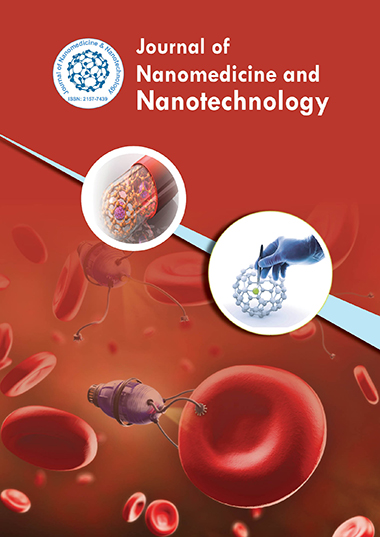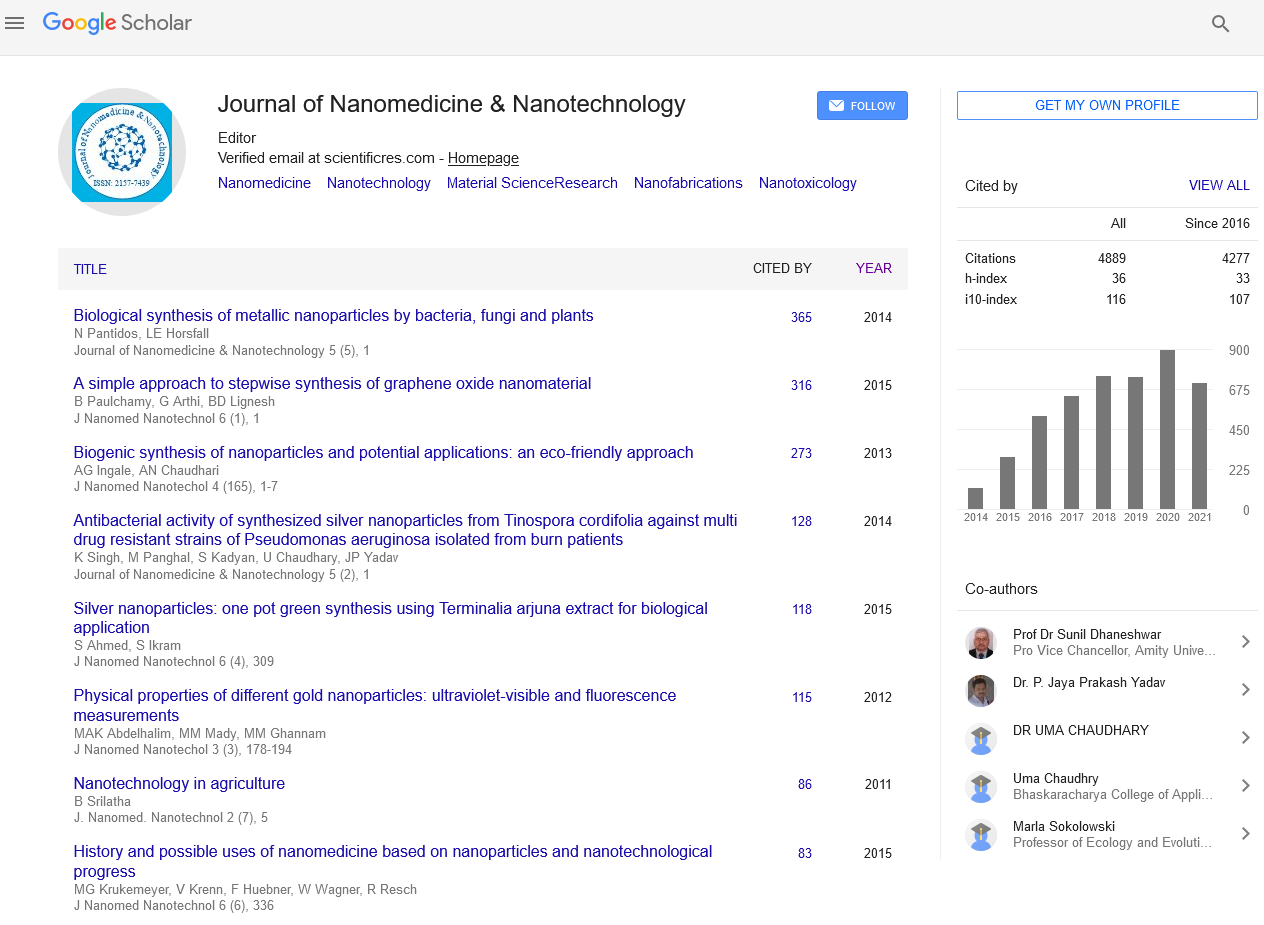Indexed In
- Open J Gate
- Genamics JournalSeek
- Academic Keys
- JournalTOCs
- ResearchBible
- China National Knowledge Infrastructure (CNKI)
- Scimago
- Ulrich's Periodicals Directory
- Electronic Journals Library
- RefSeek
- Hamdard University
- EBSCO A-Z
- OCLC- WorldCat
- SWB online catalog
- Virtual Library of Biology (vifabio)
- Publons
- MIAR
- Scientific Indexing Services (SIS)
- Euro Pub
- Google Scholar
Useful Links
Share This Page
Journal Flyer

Open Access Journals
- Agri and Aquaculture
- Biochemistry
- Bioinformatics & Systems Biology
- Business & Management
- Chemistry
- Clinical Sciences
- Engineering
- Food & Nutrition
- General Science
- Genetics & Molecular Biology
- Immunology & Microbiology
- Medical Sciences
- Neuroscience & Psychology
- Nursing & Health Care
- Pharmaceutical Sciences
Perspective - (2025) Volume 16, Issue 2
Smart and Sustainable Nanocomposites for Next-Generation Applications
Astrid Vargstrom*Received: 01-Mar-2025, Manuscript No. jnmnt-25-28604; Editor assigned: 05-Mar-2025, Pre QC No. jnmnt-25-28604 (PQ); Reviewed: 20-Mar-2025, QC No. jnmnt-25-28604; Revised: 25-Mar-2025, Manuscript No. jnmnt-25-28604 (R); Published: 31-Mar-2025
Abstract
Nanocomposites have emerged as revolutionary materials that integrate nanoscale reinforcements into a matrix to enhance mechanical, thermal, electrical, and functional properties. These materials offer significant advancements in industries such as aerospace, automotive, healthcare, and energy. With growing concerns over environmental impact, the development of smart and sustainable nanocomposites is gaining traction. By incorporating biodegradable polymers, renewable nanofillers, and self-healing capabilities, these materials provide enhanced performance while minimizing ecological footprints. This article explores the evolution, key properties, applications, challenges, and future prospects of smart and sustainable nanocomposites in next-generation technologies.
Keywords
Nanocomposites; Smart materials; Sustainable nanotechnology; Biodegradable polymers; Renewable nanofillers; Self-healing materials; Advanced composites; Green manufacturing; Next-generation applications; Energy-efficient materials
INTRODUCTION
Nanocomposites represent a class of advanced materials that combine traditional composite structures with nanoscale reinforcements to achieve superior properties. The incorporation of nanoparticles such as carbon nanotubes, graphene, nanoclays, and metal oxides enhances strength, conductivity, and durability beyond conventional materials. As industries push toward more efficient and eco-friendly solutions, the demand for smart and sustainable nanocomposites has increased. These materials not only improve functionality but also contribute to environmental sustainability by incorporating biodegradable components and reducing reliance on non-renewable resources. This article delves into the fundamental aspects, applications, and future directions of smart and sustainable nanocomposites [1,2].
DESCRIPTION
Smart and sustainable nanocomposites are engineered to exhibit responsive behaviors and environmentally friendly characteristics. Smart nanocomposites can adapt to external stimuli, such as temperature, light, and mechanical stress, enabling functionalities like self-healing, shape memory, and electrical conductivity. Sustainable nanocomposites integrate green materials, such as biopolymer matrices and natural nanofillers, to reduce carbon footprints and environmental pollution [3,4].
Several categories of nanocomposites include.
Polymer-based nanocomposites: These are widely used in packaging, biomedical devices, and coatings, offering enhanced flexibility and strength while incorporating biodegradable options.
Metal matrix nanocomposites: Used in aerospace and automotive applications, they improve strength and wear resistance while reducing overall weight.
Ceramic nanocomposites: Known for their thermal stability, they are applied in high-temperature environments and energy storage systems.
Carbon-based nanocomposites: Featuring graphene and carbon nanotubes, these materials offer excellent conductivity and mechanical properties, making them ideal for electronics and energy applications.
DISCUSSION
The growing emphasis on sustainability has led to increased research on biodegradable and bio-based nanocomposites. Using renewable materials such as cellulose nanofibers, chitosan, and starch-based nanofillers provides an eco-friendly alternative to traditional petroleum-based composites. These materials contribute to reducing plastic waste and environmental degradation [5,6].
Smart nanocomposites with self-healing properties have opened new avenues in structural health monitoring and damage prevention. By integrating microcapsules or dynamic polymer networks, these materials can repair cracks autonomously, extending their lifespan and reducing maintenance costs. Additionally, nanocomposites with shape-memory effects are being explored for aerospace and biomedical applications, where adaptive materials are essential [7,8].
Despite their benefits, nanocomposites face challenges related to large-scale production, cost, and potential toxicity of nanoparticles. Manufacturing processes must be optimized for efficiency and sustainability, ensuring minimal environmental impact. Regulatory frameworks are also crucial to addressing safety concerns associated with nanomaterial exposure and long-term usage [9,10].
CONCLUSION
Smart and sustainable nanocomposites are at the forefront of material science, offering enhanced properties while aligning with environmental goals. Their applications span various industries, from aerospace and automotive to healthcare and renewable energy. While challenges remain in cost-effective production and environmental impact assessments, continued research and technological advancements will drive the adoption of these next-generation materials. By integrating nanotechnology with sustainable practices, nanocomposites have the potential to revolutionize modern material engineering and contribute to a greener future.
ACKNOWLEDGEMENT
None
CONFLICT OF INTEREST
None
REFERENCES
- Qin B, Pei J, Guo H, Dong X, Zong B, Li D. Bioinspired nanoparticles for direct intratumoral chemotherapy of local cancer. J Mater Chem B. 2019; 7(23): 3646-3652.
- Shi Y, van Steenbergen M J, Teunissen A J P, van der Meel R, Lammers T. Drug delivery strategies for platinum-based anticancer drugs. Expert Opin Drug Deliv. 2020; 17(5): 587-604.
- Ma D, Zhang, H B, Shu W. Integration of a Nanocarrier-Based Platform for Dual-Responsive Cocktail Chemotherapy and Dual-Modal Imaging. Advanced Materials. 2019; 31(12): 1807887.
- Hobbs S K, Monsky, W L, Yuan F, Roberts W G, Griffith L, et al. Regulation of transport pathways in tumor vessels: Role of tumor type and microenvironment. Proc Natl Acad Sci. 2018; 95(8): 4607-4612.
- Dong Y, Love K T, Dorkin J R, Sirirungruang S, Zhang Y, Chen D, et al. Lipopeptide nanoparticles for potent and selective siRNA delivery in rodents and nonhuman primates. Proc Natl Acad Sci. 2018; 111(11): 3955-3960.
- Li Y, Wang Y, Huang G, Gao J, Cooper I R, Ji J, et al. Recent progress in smart drug delivery nanosystems using stimuli-responsive polymers. J Mater Chem B. 2019; 7(8): 1139-1161.
- Miao L, Huang L, Exploring N. Nano-enabled delivery of RNAi and CRISPR-Cas9 for cancer treatment. Nano Today. 2020; 32: 100853.
- Wang Z, Li X, Ying Z. Combining Magnetic Nanoparticles and Ultrasound for Drug Delivery in Cancer: A Comprehensive Review. Crit Rev Oncol Hematol. 2018; 131: 34-49.
- Lentacker I, Geers B, Demeester J. De Smedt, S. C. Advanced Delivery Strategies for Anticancer Nanomedicine. Nanomedicine. 2021; 7(2): 179-196.
- Kieran D, Woods A, Villalta-Cerdas A, Weiner S. Tumor-associated antigens for the induction of antitumor immune responses. Annual Review of Immunology. 2020; 39: 251-272.
Indexed at, Google Scholar, Crossref
Indexed at, Google Scholar, Crossref
Indexed at, Google Scholar, Crossref
Indexed at, Google Scholar, Crossref
Indexed at, Google Scholar, Crossref
Indexed at, Google Scholar, Crossref
Indexed at, Google Scholar, Crossref
Indexed at, Google Scholar, Crossref
Citation: Astrid V (2025) Smart and Sustainable Nanocomposites for Next-Generation Applications. J Nanomed Nanotech. 16: 780.
Copyright: ©2025 Astrid V. This is an open-access article distributed under the terms of the Creative Commons Attribution License, which permits unrestricted use, distribution, and reproduction in any medium, provided the original author and source are credited.


